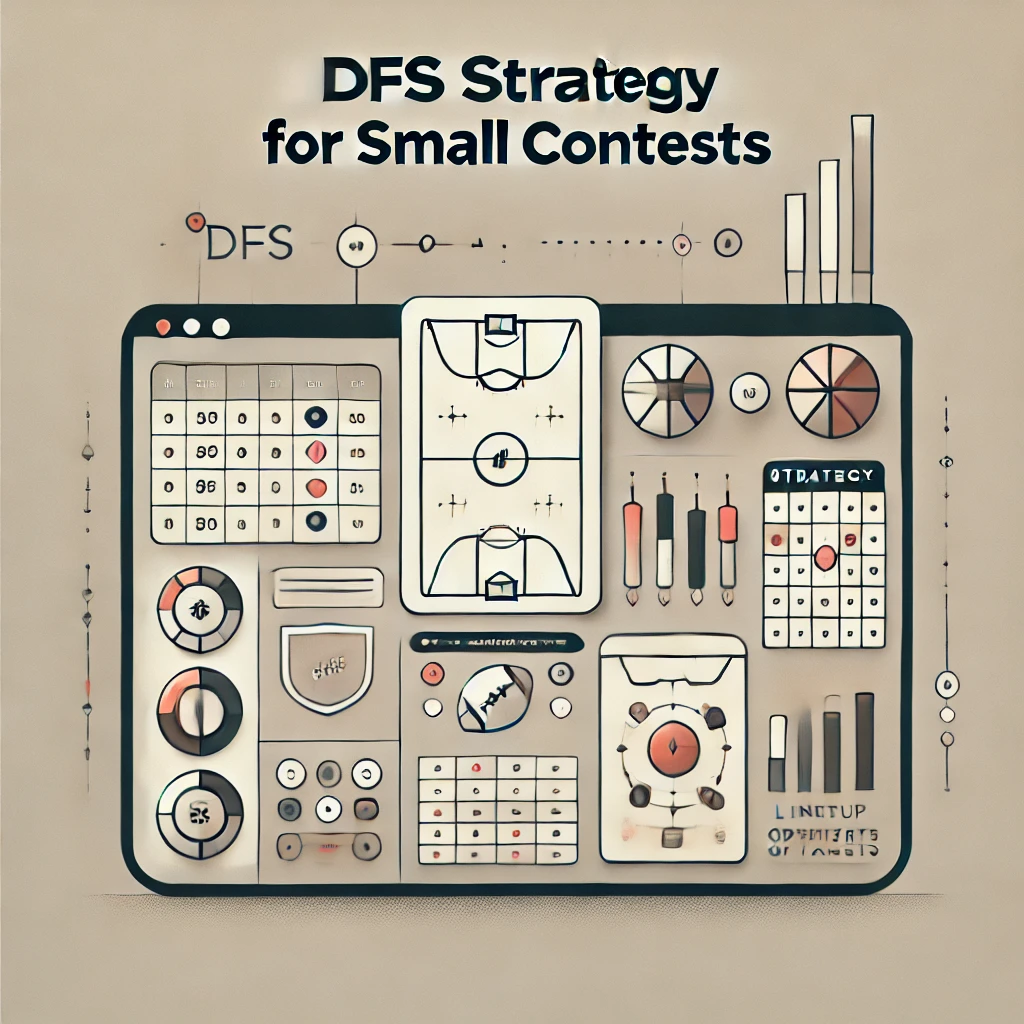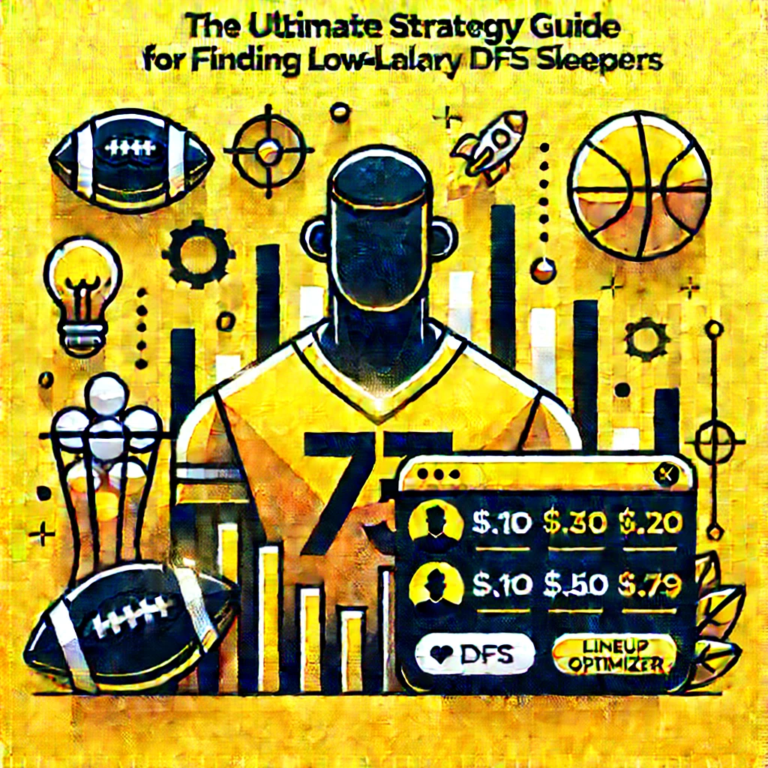DFS Strategy for Small Contests
Daily Fantasy Sports (DFS) offers an exciting way for sports fans to engage with their favorite teams and athletes. While large tournaments attract attention with their big prizes, small contests often present a better chance for consistent wins if you apply the right strategies. In small-field contests, where the number of participants is limited, you don’t need the same high-risk, high-reward plays that are necessary to win large GPPs. Instead, a more balanced, steady approach can yield positive results.
In this article, we’ll break down the best DFS strategy for small contests, providing tips to help you succeed in these formats.
Table of Contents
- What Are Small Contests in DFS?
- Understanding Contest Size and Structure
- Key Strategies for Small DFS Contests
- The Role of Ownership Projections
- Analyzing Opponent Trends
- Game Theory and Late Swapping
- Leveraging DFS Tools and Optimizers
- Common Mistakes to Avoid in Small DFS Contests
- Final Thoughts on DFS Strategy for Small Contests
What Are Small Contests in DFS?
Small contests in DFS are contests that have fewer participants compared to the large-field GPPs. These contests include:
- Head-to-Head (H2H): A one-on-one matchup where you only need to outscore a single opponent to win.
- 3-man, 5-man, and 10-man leagues: These leagues reward the top 1-3 participants depending on the contest size.
- 50/50s and Double-Ups: Contests where the top 50% of participants receive a payout, offering a lower-risk, lower-reward approach.
- Small-field Tournaments: These tournaments have around 100-200 participants, providing a middle ground between cash games and large-field GPPs.
In small contests, your goal is to beat just a few participants, so consistency and balance are key to building a winning lineup.
Understanding Contest Size and Structure
The structure of small DFS contests significantly affects how you should approach your strategy. Since you’re competing against fewer entries, you don’t need to differentiate your lineup as much as you would in larger tournaments.
Instead of swinging for the fences with high-variance plays, you can focus on floor—players who consistently perform. For example, a star NFL running back who receives both rushing and receiving touches provides a high floor and is often a safer play than a boom-or-bust wide receiver.
Key Differences Between Small Contests and Large GPPs:
- Reduced Need for Differentiation: In small contests, it’s okay to use more “chalk” players (highly owned, popular picks) as long as they are good plays.
- Less Risk Required: You don’t need to roster extremely risky players in small contests. A balanced lineup of consistent performers is usually the best approach.
Key Strategies for Small DFS Contests
Emphasize Floor Over Ceiling
In small contests, you don’t need the absolute highest possible score to win. Instead, you should focus on high-floor players who can consistently deliver solid point totals even if they don’t explode for huge games. The goal is to outscore just a few other competitors, so you don’t need to gamble on high-risk, high-reward players as often.
Examples of High-Floor Players:
- NFL DFS: Running backs like Christian McCaffrey, who are heavily involved in both the rushing and receiving game, offer a great floor. Quarterbacks with rushing upside, such as Lamar Jackson, also provide a higher floor thanks to their dual-threat capabilities.
- NBA DFS: Players who contribute in multiple stat categories, such as Nikola Jokic or James Harden, have high floors because they contribute across points, rebounds, and assists.
- MLB DFS: Batters with high on-base percentages and consistent at-bats, such as Mookie Betts or Juan Soto, offer strong floors for cash games and small contests.
Balanced Lineups Over Stars-and-Scrubs
The “stars-and-scrubs” approach, where you pay up for a few high-priced stars and then fill out your roster with low-priced players, can be risky in small contests. Instead, a balanced lineup that targets mid-tier players with consistent roles is often more effective.
Building a Balanced Roster:
- NFL: Rather than paying up for two elite wide receivers and punting on cheaper options, balance your lineup with mid-priced players who consistently produce.
- NBA: A balanced approach involves selecting players who are sure to log heavy minutes and fill up the stat sheet across multiple categories.
- MLB: Avoid chasing home run hitters who are boom-or-bust; instead, prioritize contact hitters and pitchers with high strikeout rates.
Strategic Stacking in Small Contests
Stacking players (pairing multiple players from the same team or game) can increase the correlation between players’ performances. While full-game stacks are often necessary in GPPs, mini stacks are more appropriate for small contests.
Examples:
- In NFL DFS, pairing a quarterback with one of his wide receivers or tight ends provides correlation without overexposing your lineup to a single team.
- In NBA DFS, stacking a point guard with a center who benefits from pick-and-roll plays can yield a solid, consistent point total.
- In MLB DFS, pairing a pitcher with one or two hitters from the same team can offer synergy without relying on a single game for all your production.
The Role of Ownership Projections
Ownership projections are crucial in large-field GPPs where you want to avoid overly popular players, but in small contests, high ownership isn’t as big of an issue. You can roster popular players as long as they offer good value, but it’s important to sprinkle in a few contrarian plays if you want to gain an edge.
- Leveraging chalk: In small contests, it’s fine to roster chalk players as long as they are in favorable situations.
- Contrarian plays: While you don’t need to chase low-owned players, including one or two contrarian plays can give you an edge over your competitors if they perform well.
Analyzing Opponent Trends
One overlooked aspect of DFS strategy for small contests is analyzing your opponents. In small leagues or head-to-head contests, it’s possible to identify trends in how your opponents construct lineups.
- Opponent tendencies: Some players prefer to stack certain teams, while others may consistently overpay for star players. Understanding these tendencies can help you build a lineup that takes advantage of their predictable strategies.
- Exploiting trends: If an opponent consistently stacks a certain team, you can diversify by choosing different matchups, increasing your chances of success if their stack underperforms.
Game Theory and Late Swapping
Late swapping can be a critical advantage in DFS, particularly in sports like NBA and NFL where injury news or lineup changes come out after the first games lock.
- Late swap for leverage: If you’re trailing after the early games, pivoting to lower-owned players in the later games can help you gain ground.
- Injury news: Stay on top of injury updates and lineup changes, as these often create value plays that other players might miss. This is particularly important in NBA DFS, where late injury news is common.
Leveraging DFS Tools and Optimizers
DFS tools like lineup optimizers and projection models are invaluable in building strong lineups for small contests. One of the best tools to use is the Draft Dashboard. This tool allows you to analyze player projections, matchups, and ownership trends to create well-balanced lineups.
Draft Dashboard for Small Contests
With Draft Dashboard, you can:
- Optimize lineups: Use projections to find the best combinations of players based on their expected performance.
- Analyze matchups: See which players have favorable matchups, ensuring your lineup is built for success.
- Review ownership trends: Understand which players will be highly owned and decide when to pivot away from chalk.
By using tools like Draft Dashboard, you can fine-tune your strategy and build lineups that succeed consistently in small contests.
Common Mistakes to Avoid in Small DFS Contests
While small contests are more forgiving than large GPPs, there are still a few common mistakes to avoid:
- Chasing upside only: In small contests, it’s more important to target consistent performers than to chase boom-or-bust players.
- Over-stacking: While stacking can be effective, it’s dangerous to overexpose your lineup to one game in small contests.
- Ignoring late swap opportunities: Failing to adjust your lineup based on late news can put you at a disadvantage, especially in NBA DFS.
Final Thoughts on DFS Strategy for Small Contests
Small DFS contests provide an excellent opportunity to consistently cash if you use the right strategy. By focusing on high-floor players, building balanced lineups, and taking advantage of tools like Draft Dashboard, you can improve your performance in these formats.
Don’t forget to analyze opponent trends and use late swap opportunities when necessary. While small contests don’t come with the massive payouts of large GPPs, they offer a more stable path to long-term DFS success.


